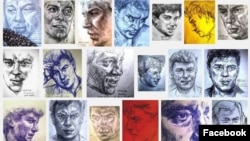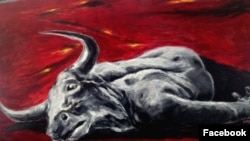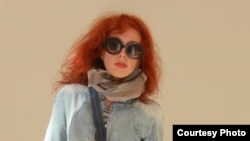Five days before Russian opposition politician Boris Nemtsov was gunned down on a bridge near the Kremlin in Moscow, artist Lena Hades completed a painting for her series of visualizations of philosopher Frederick Nietzsche's Thus Spake Zarathustra.
She posted the image, which shows a slaughtered bull with the body of a man staring lifelessly at the viewer against a lurid background of blood, late in the evening on February 27.
"I was not involved in politics," she told RFE/RL by telephone from her home in Moscow, although she did hold a 25-day hunger strike in 2012 to support the jailed performance-art group Pussy Riot. "I was interested, but I never went to any protests. I was busy with my art. But I published [the bull painting] around 10 p.m. and an hour and a half later someone wrote to me: 'Lena, you are a prophet! They have murdered Nemtsov. [Your painting] is him.'"
Many of Hades's friends posted on social media images of Nemtsov's body that hauntingly echoed Hades's painting.
Later Hades learned that an optimistically advancing bull was the emblem of Nemtsov's original Parnas political party.
Little did she realize that that coincidence would prompt her to spend an entire year looking into Boris Nemtsov's eyes. She began drawing daily portraits of Nemtsov and on March 3 announced her Art Marathon project in his memory.
"From then I worked every day -- I drew and listened to his speeches, read his interviews," she says. "His voice was constantly in my soul. Constantly."
Much In Common
Hades discovered other coincidences connecting her with Nemtsov. They were born within a week of each other. Both were excellent students, specializing in science. Both were natural leaders from an early age. Both followed their passions from one career to another; in Nemtsov's case from science to politics and in Hades's, from science translation to art.
Hades became an artist only at the age of 35, but since then has participated in more than 70 exhibitions around the world. Her works are in the collection of the Moscow Museum of Modern Art and the Igor Markin Museum of Modern Art, as well as private collections.
A year later, the project is coming to a close with more than 400 total images. Taken individually, the sketches are rough and unfinished -- reminiscent of Nemtsov's tragically shortened life. Taken together, they are reminiscent of the walls of portraits of victims that one often sees in Holocaust museums or at memorials dedicated to the victims of totalitarianism.
"I want to attract attention to the theme of violence," Hades says, "to the topic of opponents of totalitarian regimes who are murdered."
"This project is devoted to the victims of totalitarian regimes, personified by Nemtsov," she adds.
As the Art Marathon phase of Hades's project comes to an end -- and she hopes to arrange exhibitions of the portraits in Russia and abroad -- the 55-year-old artist is moving "seamlessly" to the next phase, devoted to the artists and intellectuals who were killed during Stalin's Great Terror. Like Nemtsov, she says, those people had the stolen potential to change Russia's course for the better.
"I consider this a continuation of the Nemtsov theme -- he was also murdered by a totalitarian regime," Hades says. "It is a very important work for me and I am going to work seriously on it for a long time. The first thing I'm going to do is visit the Butovsky Firing Range, which is not far from here and where many, many people perished [executed by Stalin's secret police]."
The victims of Butovsky and other secret-police killing sites under Stalin were shot from behind at close range, just as Nemtsov was.
"As a citizen, as a feminist, as an artist, as a person, I hate violence," Hades says. "I hate totalitarian regimes."
ALSO READ: Russia Marks One Year Since Nemtsov Killing
Unexpectedly though, a year of scratching out portraits of Nemtsov has not weighed heavily on Hades. When she speaks of how the process has affected her, she slips naturally into the present tense, as if Nemtsov were still alive. She says the process has made her "more sure of herself."
"He is very open, very charismatic, and kind," she says. "These are qualities that I treasure and that I am learning from him. How to look at the world more optimistically, maybe is a good way to put it. And that makes me happy."















